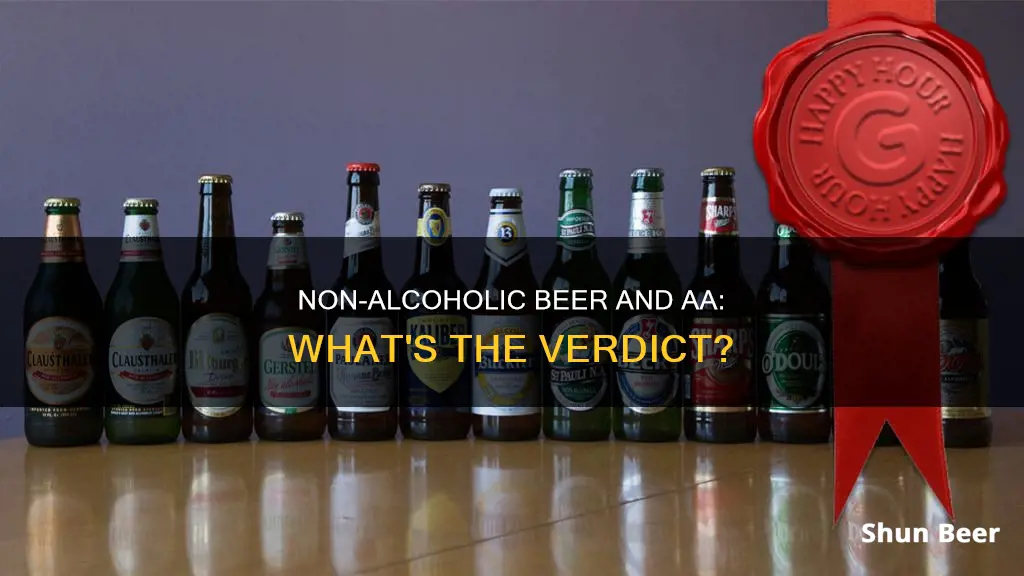
Whether or not people in Alcoholics Anonymous (AA) can drink non-alcoholic beer is a highly debated topic, with strong opinions on both sides. Some people believe that non-alcoholic beer is a valuable alternative for those looking to moderate their alcohol intake, while still enjoying the taste of beer. On the other hand, some say that non-alcoholic drinks are dangerous for people in recovery, as they provide a loophole for those not serious about their sobriety.
| Characteristics | Values |
|---|---|
| Alcohol content | Non-alcoholic beer is defined as beer with 0.5% or less alcohol by volume (ABV). |
| Legality | In the US, non-alcoholic beer can legally contain up to 0.5% ABV. Products marketed as alcohol-free must contain 0% ABV. |
| Taste | Non-alcoholic beer is designed to mimic the taste of regular beer. |
| Safety | Non-alcoholic beer may be unsafe for people with alcohol use disorder, as it can trigger cravings and a subsequent relapse. |
| Health benefits | Non-alcoholic beer is typically lower in calories and carbohydrates than regular beer. |
| Social benefits | Non-alcoholic beer can help people in recovery feel included in social situations where alcohol is present. |
| Risks | Non-alcoholic beer may contain more alcohol than advertised. A 2010 study found that 29% of tested non-alcoholic beers had higher alcohol levels than stated on the label. |
What You'll Learn

Non-alcoholic beer may contain alcohol
Non-alcoholic beer is often marketed as a safe alternative to alcoholic beer. However, it is important to note that non-alcoholic beer may still contain small amounts of alcohol. By law, non-alcoholic beers can contain up to 0.5% alcohol by volume (ABV). This means that while you are very unlikely to get drunk from drinking non-alcoholic beer, it does still contain alcohol.
Research has found that many non-alcoholic beers contain more alcohol than is stated on their labels. A 2010 study published in the Canadian Journal of Clinical Pharmacology found that out of 45 non-alcoholic beers, 29% had higher alcohol levels than declared, and six beers labelled as 0.0% ABV were found to contain alcohol, with levels up to 1.8% ABV. This discrepancy may be due to the complex processes required to remove alcohol from beer, which often involve heating or straining the beer, and then adding liquid and carbonation back in.
The presence of alcohol in non-alcoholic beer can pose risks for certain groups of people. For example, pregnant women are advised to avoid all alcohol to eliminate the risk of fetal alcohol spectrum disorder (FASD). As there is no known safe amount of alcohol during pregnancy, non-alcoholic beer may not be a safe alternative for expectant mothers.
People with liver damage or liver disease should also be cautious about consuming non-alcoholic beer. Research has shown that drinking non-alcoholic beer can cause significantly higher blood alcohol levels in people with liver impairments. This may lead to positive alcohol urine or breath tests, even when only small amounts of alcohol have been consumed.
For individuals recovering from alcoholism or alcohol use disorder, non-alcoholic beer may also pose risks. The smell and taste of non-alcoholic beer may be enough to trigger cravings and a subsequent relapse. As many as 90% of alcoholics will experience a relapse in the four years after quitting drinking, so it is important for people in recovery to be aware of their triggers and avoid high-risk situations.
In summary, while non-alcoholic beer may be a good option for some people looking to reduce their alcohol intake, it is important to remember that it may still contain small amounts of alcohol. This can pose risks for pregnant women, individuals with liver damage, and those recovering from alcoholism or alcohol use disorder. As always, it is important to read labels carefully and make informed choices about your health and well-being.
Beer and Buspirone: Is It Safe to Mix?
You may want to see also

The pros of non-alcoholic beer for people in AA
Non-alcoholic beer can help people in AA feel included in social situations. Many people in AA struggle with feeling isolated when they are in social situations where alcohol is being consumed. Not being able to take part in a seemingly normal activity, such as having a beer at a ball game, can make people in AA feel awkward and excluded. Non-alcoholic beer allows them to blend in and feel like part of the group without compromising their sobriety.
Non-alcoholic beer can also help people in AA feel like they are not missing out on the experience of drinking alcohol. Some people in AA may feel that they are unable to enjoy the sensation and experience of drinking alcohol, and the ritual around drinking can be almost as addictive as the alcohol itself. Non-alcoholic beer allows them to occasionally enjoy a drink and still keep sobriety an attainable goal.
Non-alcoholic beer can also be a valuable stepping stone to total abstinence. For some people, the idea of never drinking alcohol again can be so depressing that they don't even try to quit. Non-alcoholic drinks can help people begin to restrict their drinking and address their addiction, and they may ultimately choose total abstinence.
Non-alcoholic beer can also provide health and relaxation benefits. These drinks are generally made from only four natural ingredients – water, yeast, malt, and hops – with barely any preservatives or added sugars. They can help people relax and unwind in stressful situations and aid insomnia, without the negative consequences of drinking alcohol.
Finally, non-alcoholic beer is very unlikely to get you drunk. You would have to drink an obscene amount to get anywhere near the intoxication range, so it is a safe alternative for people in AA who want to avoid the risks associated with drinking alcohol.
Beer and Prediabetes: What's the Verdict?
You may want to see also

The cons of non-alcoholic beer for people in AA
Non-alcoholic beer can be a trigger for people in AA. The smell and taste of non-alcoholic beer may be enough to trigger a relapse in some individuals, as it can bring back memories of drinking. The ritual around drinking may also be a trigger, as the sound of opening a can or the feel of a cold glass can stimulate the reward centres of the brain and release dopamine. This can cause a craving for real alcohol and potentially lead to a devastating relapse.
The concept of "euphoric recall" is also a risk, where people selectively remember the good times of drinking and forget the negative consequences. This can cloud judgement and lead to poor decisions, including relapse.
For some in recovery, any amount of alcohol is too much, and the idea of consuming even a non-alcoholic beer with trace amounts of alcohol can be disturbing and triggering. Research has shown that non-alcoholic beers often contain more alcohol than their labels indicate, and people with liver impairments may develop much higher blood alcohol levels than normal after consuming them.
The name "non-alcoholic beer" is misleading, as these beverages do contain alcohol (up to 0.5% ABV). For those in AA, it is important to be aware of the risks and make an informed decision about whether to consume non-alcoholic beer. It is crucial to know your triggers and avoid high-risk situations.
While non-alcoholic beer may provide a sense of normalcy and help people in AA feel included in social situations, it is important to consider the potential dangers and make a decision that aligns with your recovery goals.
Beer on the Beach: Drinking Laws on Hilton Head Island
You may want to see also

The risks of non-alcoholic beer for people in AA
Non-alcoholic beer is often marketed as a safe alternative to regular beer, but it may pose certain risks for people in Alcoholics Anonymous (AA) or other recovery programs. While non-alcoholic beer typically contains very little alcohol, it is not always alcohol-free, and even small amounts can be risky for people in recovery from alcohol use disorder.
Potential Presence of Alcohol
Although non-alcoholic beers are typically defined as having less than 0.5% alcohol by volume (ABV), this limit is not always accurate. Research has shown that some non-alcoholic beers contain higher levels of alcohol than advertised, with some samples containing over 1% ABV. This discrepancy can be dangerous for people in AA, as even small amounts of alcohol can be triggering or compromise their sobriety.
Triggers and Cravings
The smell, taste, and appearance of non-alcoholic beer closely resemble those of regular beer. For people in AA, these sensory cues can evoke powerful memories of drinking and trigger intense cravings. The concept of "euphoric recall" refers to the selective memory of the positive aspects of drinking, while the negative consequences are forgotten or minimised. This can cloud judgment and increase the risk of relapse.
Additionally, the ritual of drinking beer, such as cracking open a can or bottle, can stimulate the brain's reward centres and release dopamine, potentially leading to a craving for alcoholic beer.
Individual Responses
The impact of non-alcoholic beer varies from person to person. Some people in AA may find that these beverages help them feel included in social situations without compromising their sobriety. However, others may view any consumption of non-alcoholic beer as a relapse or a sign of not being serious about recovery. It is crucial for individuals to assess their own triggers and make informed decisions about their consumption.
Recommendations for People in AA
The decision to consume non-alcoholic beer during recovery is a personal one and should be based on an individual's unique situation and triggers. It is generally recommended that people in early recovery avoid non-alcoholic beer, as they may be more vulnerable to triggers and cravings. As people progress in their recovery journey, the decision may become more individualised, with some finding that true 0.0% alcohol-free beers provide a safe alternative.
To minimise risks, it is essential for people in AA to be aware of their triggers and avoid high-risk situations. This may include avoiding places where there is excessive drinking or having a backup plan and support system in place when attending social events where alcohol is present.
Monkeys and Beer: A Safe Combination?
You may want to see also

The benefits of non-alcoholic beer for people in AA
Non-alcoholic beer is a type of beer that contains very little or no alcohol. It is usually produced by removing the alcohol from regular beer. While this process does remove most of the alcohol, small amounts may remain. For example, a non-alcoholic beer typically contains around one gram of alcohol, whereas a regular beer contains about 14 grams.
The Benefits
There are several benefits to non-alcoholic beer for people in Alcoholics Anonymous (AA). Firstly, it can help people in recovery feel included in social situations where alcohol is present. Feelings of isolation are common in early recovery, and non-alcoholic beer can help people feel like they are still part of the group without worrying about getting drunk. It can also be a way to unwind and relax without compromising sobriety.
Another benefit is that non-alcoholic beer allows people to enjoy the taste of beer without the negative consequences of alcohol. Some people genuinely enjoy the taste of beer and may have considered themselves beer connoisseurs before their drinking became a problem. Non-alcoholic beer gives them the ability to occasionally enjoy a drink while still maintaining their sobriety.
Non-alcoholic beer can also be a valuable stepping stone for people who are not yet ready to commit to total abstinence. It provides an opportunity to begin restricting their drinking and addressing their addiction, with the ultimate goal of achieving total abstinence.
Potential Risks
It is important to note that non-alcoholic beer is not completely risk-free for people in AA. The biggest concern is the potential for it to trigger a relapse. The smell and taste of non-alcoholic beer may be enough to trigger cravings and lead to a relapse, especially if the person associates the taste with the "good times" of drinking. Additionally, the very idea of consuming alcohol, even in trace amounts, may be disturbing to some people in recovery.
It is also worth mentioning that many non-alcoholic beers still contain small amounts of alcohol. In the United States, by law, non-alcoholic beers can contain up to 0.5% alcohol by volume (ABV). While it is unlikely for a person to get drunk from drinking non-alcoholic beer, it is important for people in AA to be aware of this and make an informed decision about whether it is right for them.
Individual Decision
Ultimately, the decision to drink non-alcoholic beer during recovery is a personal one. What works for one person may not work for another. It is important for individuals to know their triggers and stay away from them. If non-alcoholic beer helps someone feel included and reduces feelings of isolation, it may be a beneficial tool during recovery. However, if it triggers cravings or negative memories, it is best avoided.
Each person's recovery journey is unique, and it is crucial to evaluate one's own situation and decide whether the benefits of non-alcoholic beer outweigh the potential risks.
Beer and Apple: A Delicious Pairing?
You may want to see also
Frequently asked questions
There is no definitive answer to this question as it depends on the individual's recovery journey and their ability to recognize and deal with triggers. However, it is important to note that non-alcoholic beers typically contain up to 0.5% alcohol, and some people in recovery choose to avoid it completely to maintain their sobriety.
Non-alcoholic beer is a type of beer that contains very little or no alcohol, typically less than 0.5% alcohol by volume (ABV). It is often produced by removing the alcohol from regular beer, through processes such as controlled fermentation, dealcoholization, dilution, or simulated fermentation.
Non-alcoholic beer can provide a sense of inclusion and normalcy for people in AA, allowing them to feel part of social situations and enjoy the taste of beer without compromising their sobriety. It can also be a stepping stone towards ultimate sobriety for those who are not yet ready to commit to total abstinence.
The biggest concern is the potential for non-alcoholic beer to trigger a relapse. The taste, smell, and rituals associated with drinking beer can stimulate the reward centers of the brain and trigger "euphoric recall," where the positive aspects of drinking are romanticized while the negative consequences are forgotten. Additionally, some non-alcoholic beers may contain higher levels of alcohol than indicated on their labels.
It is crucial for individuals in AA to be aware of their triggers and have effective strategies to deal with them. They should consider their own recovery journey, seek guidance from sponsors or support groups, and make an honest assessment of their ability to maintain sobriety while consuming non-alcoholic beer.







